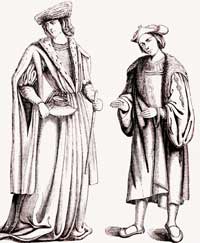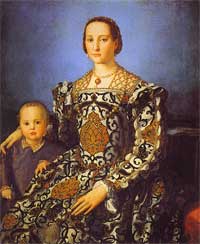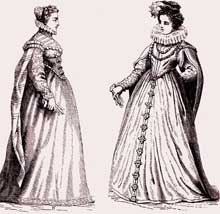Renaissance Fashion
The Italian Renaissance fashion, which exhibited better taste and a greater amount of elegance, greatly influenced the way people dressed in other countries of Europe. In France, the import of Italian fashion dates from the famous expedition of Charles VIII into Italy.
Full and gathered or puffed sleeves, which gave considerable gracefulness to the upper part of the body, succeeded to the mahoitres, which had been discarded since the time of Louis XI. By the end of the 15th Century, men's Renaissance fashion imposed a short and ornamental mantle, a broad-brimmed hat covered with feathers, and trunk hose, the ample dimensions of which earned for them the name of trousses. Women wore the bodies of their dresses closely fitting to the figure, embroidered, trimmed with lace, and covered with gilt ornaments; the sleeves were very large and open, and for the most part they still adhered to the heavy and ungraceful head-dress of Queen Anne of Brittany.

Court of Charles VIII.
Clothing before and after
the Expedition into Italy
The principal characteristic of the Renaissance female dress was its fullness; men's, on the contrary, with the exception of the mantle or the upper garment, was usually tight and very scanty.
During the 16th Century, the Renaissance fashion is making a distinct separation between ancient and modern dress; in fact, our present fashions may be said to have taken their origin from about that time. It was during this century that men adopted clothes closely fitting to the body; overcoats with tight sleeves, felt hats with more or less wide brims, and closed shoes and boots.
The women also wore their dresses closely fitting to the figure, with tight sleeves, low-crowned hats, and richly-trimmed petticoats. These Renaissance fashion garments, which differ altogether from those of antiquity, constitute the common type from which have since arisen the endless varieties of male and female dress; and there is no doubt that fashion will thus be continually changing backwards and forwards from time to time, sometimes returning to its original model, and sometimes departing from it.

Bronzino
Eleonora di Toledo and her son (1545)
Uffizi, Florence
During the 16th Century, ladies wore the skirts of their dresses, which were tight at the waist and open in front, very wide, displaying the lower part of a very rich under-petticoat, which reached to the ground, completely concealing the feet. This, like the sleeves with puffs, which fell in circles to the wrists, was altogether a typical fashion of the Italian Renaissance. Frequently the hair was turned over in rolls, and adorned with precious stones, and was surmounted by a small cap, coquettishly placed either on one side or on the top of the head, and ornamented with gold chains, jewels, and feathers. The body of the dress was always long, and pointed in front.
Men wore their coats cut somewhat after the same shape: their trunk hose were tight, but round the waist they were puffed out. They wore a cloak, which only reached as far as the hips, and was always much ornamented; they carried a smooth or ribbed cap on one side of the head, and a small upright collar adorned the coat. This collar was replaced, after the first half of the 16th Century, by the high, starched ruff, which was kept out by wires; ladies wore it still larger, when it had somewhat the appearance of an open fan at the back of the neck.
In Italy, home of the Renaissance fashion, dress always maintained a certain character of grandeur, ever recalling the fact that the influence of antiquity was not quite lost. In Germany and Switzerland, garments had generally a heavy and massive appearance; in Holland, still more so. England uniformly studied a kind of instinctive elegance and propriety. It is a curious fact that Spain invariably partook of the heaviness peculiar to Germany, either because the Gothic element still prevailed there, or that the Walloon fashions had a special attraction to her owing to associations and general usage. France was fickle and capricious, fantastical and wavering, but not from indifference, but because she was always ready to borrow from every quarter anything which pleased her. She, however, never failed to put her own stamp on whatever she adopted, thus making any fashion essentially French, even though she had only just borrowed it from Spain, England, Germany, or Italy.
Under Francis I., the Renaissance fashion adopted from Italy remained almost stationary. Under Henri II., and especially after the death of that prince, the taste for frivolities made immense progress, and the style of dress in ordinary use seemed day by day to lose the few traces of dignity which it had previously possessed.

Court of Catherine de' Medici
Ladies Clothing
The Renaissance fashion evolved when Catherine de' Medici had introduced the fashion of ruffs, and Marie de' Medici that of small collars. Dresses tight at the waist began to be made very full round the hips, by means of large padded rolls, and these were still more enlarged, under the name of certugadins (corrupted from vertu-gardiens), by an arrangement of padded whalebone and steel, which subsequently became the paniers.
Under the last of the Valois, men's dress was short, the jacket was pointed and trimmed round with small peaks, the velvet cap was trimmed with aigrettes; the beard was pointed, a pearl hung from the left ear, and a small cloak or mantle was carried on the shoulder, which only reached to the waist. The use of gloves made of scented leather became universal. Ladies wore their dresses long, very full, and very costly, little or no change being made in these respects during the reign of Henry IV. At this period, the men's high hose were made longer and fuller, especially in Spain and the Low Countries, and the fashion of large soft boots, made of doeskin or of black morocco, became universal, on account of their being so comfortable.
We may remark that the clothing of the bourgeois was for a long time almost unchanged, even in the towns. Never having adopted either the tight-fitting hose or the balloon trousers, they wore an easy jerkin, a large cloak, and a felt hat, which the English made conical and with a broad brim.
The last changes in the Renaissance fashion were done towards the beginning of the 17th Century. The high hose worn by the northern nations, profusely trimmed, was transformed into the culotte, which was full and open at the knees. A division was thus suddenly made between the lower and the upper part of the hose, as if the garment which covered the lower limbs had been cut in two, and garters were then necessarily invented. The felt hat became over almost the whole of Europe a cap, taking the exact form of the head, and having a wide, flat brim turned up on one side. High heels were added to boots and shoes, which up to that time had been flat and with single soles.